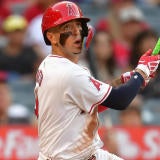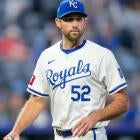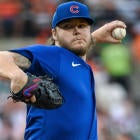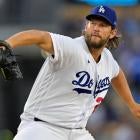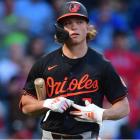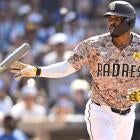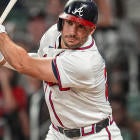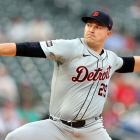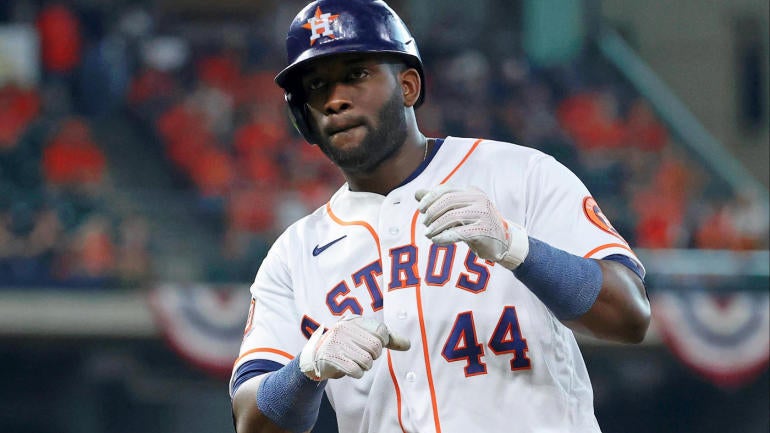
If a picture is worth a thousand words, a number is worth, like, 50. I don't know the conversion rate exactly, but it's high enough to suggest I'm wasting my breath with all the words. So here are some numbers instead.
If you're a real glutton for Fantasy Baseball content, chances are you'll see (or hear) me cite these numbers elsewhere. This article serves as almost a repository of tidbits for me to reference as needed. But it's also a helpful compilation for you, cutting out much of the fat and getting right to the heart of the matter.
I'll admit that some of these stats are more meaningful than others, but they're all interesting, if nothing else. I may even see fit to add some new ones as I uncover them in the weeks ahead, but this should be enough to get us started.
- For all the conspiracy theories about MLB helping Aaron Judge to 62 home runs by mixing in more buoyant baseballs down the stretch, his historic season was remarkably consistent. After homering just six times in April, he hit between nine and 13 home runs in each of the other five months
- Judge's 62 home runs were 16 more than the next-closest player, Kyle Schwarber. It was the biggest gap between 1 and 2 in a year when someone hit 60. Even when Babe Ruth did it in 1927, Lou Gehrig managed to come within 13.
- Tying for third in home runs was Mike Trout with 40, but what's interesting in his case is he did it in only 119 games. If he maintains that pace over a full 162 games, he's at 54 home runs.
- So Judge averaged a home run every 11.2 plate appearances and Trout every 12.5 plate appearances. Beating them both was 37-year-old Matt Carpenter, who homered every 10.3 plate appearances for the 47 games he was healthy. He homered 15 times in all, slashing .305/.412/.727.
- For as much of an outlier as Aaron Judge was in the home run column, one player did compare by raw skill indicators, rating in the 99th or 100th percentile for basically every quality-of-contact metric on Statcast. It's Yordan Alvarez. He ranked behind only Judge in average exit velocity, hard-hit rate, barrel rate and xwOBA. And then there's xSLG, where Judge clocked in at .706 and Alvarez at .672. Third place (Trout) was all the way down at .583.
- Between 2019, the last full year before any minor-league level adopted the new pickoff rules soon to be introduced to the majors, and 2022, the first full year that every level had them, stolen bases attempts increased from 2.23 to 2.83 per game. The rate of success on those attempts improved from 68 to 77 percent.
- Freddie Freeman's first year with the Dodgers saw him hit just 21 home runs, his fewest for a full-length season since 2015. He was still the third-best Rotisserie player, according to the CBS rating system.
- Gerrit Cole's 3.50 ERA ranked 30th among the 45 qualifying pitchers. None of the other top 15 starting pitchers by ADP had an ERA above 3.25.
- Bo Bichette's final numbers weren't so unlike 2021, but it took a massive final month to get there. He hit .406 (54 for 133) with seven homers, four steals and a 1.105 OPS in September, raising his season batting average from .260 to .290 and his season OPS from .725 to .802.
- Bobby Witt, who early ADP has as a first-rounder, may have had 20 homers and 30 steals as a rookie last year, but he reached base at only a .294 clip, the 14th-worst mark among qualifying batters. His .722 OPS was worse than that of Jurickson Profar.
- In his 24 starts before missing a couple weeks late in the year with a shoulder impingement, Shane McClanahan's swinging-strike rate was 16.3 percent. In his five starts after returning, postseason included, his swinging-strike rate was only 10 percent.
- Michael Harris' 56.2 percent ground-ball rate would have been second-worst among qualifiers, behind only Christian Yelich. Could he have maintained his .217 ISO over a full season? Well, the only qualifier with a ground-ball rate of even 50 percent to have better than a .200 ISO was Vladimir Guerrero.
- Bryan De La Cruz, who came back from the minors to hit .388 (33 for 85) with six home runs last September, had a .287 xBA, and .498 xSLG for the year. Compare those to Rafael Devers' .282 xBA and .497 xSLG.
- NL Cy Young winner Sandy Alcantara had 16 starts of not just six innings or more, not just seven innings or more, but more than seven innings. The No. 2 pitcher in total innings, Aaron Nola, had just seven starts like that.
- With 22 home runs and 21 stolen bases, J.T. Realmuto became only the second 20/20 catcher ever and the first since Ivan Rodriguez in 1999. All it took was him batting .319 with 15 homers and 10 steals after the All-Star break.
- NL Rookie of the Year runner-up Spencer Strider became the fastest ever to 200 strikeouts, doing so in 130 innings. He also became the first pitcher to strike out 200 while allowing fewer than 100 hits.
- En route to a 2.20 ERA overall, Dylan Cease had a 14-start stretch from late May through early August in which he delivered a 0.66 ERA, allowing just six earned runs. He also allowed 10 unearned runs.
- Corey Seager, who hit a career-low .245 despite having a career-high 33 home runs, batted just .242 against the shift, according to FanGraphs. He entered with a career .332 batting average against the shift.
- Adolis Garcia managed to score 88 runs despite reaching base at a .300 clip. He was only the seventh player this century to score so many runs with an OBP so low.
- Oneil Cruz's 122.4 mph single off the fence on Aug. 24 wasn't just the hardest-hit ball of the season. It was the hardest-hit of the Statcast era, which dates back to 2015.
- Clearly, quality of contact was less of an issue for Cruz than quantity, but he managed to cut his strikeout rate to a salvageable 29.8 percent in September and wound up hitting .288 (34 for 118) with six homers, five steals and an .884 OPS for the month. He entered it batting .202 with a .665 OPS.
- Kevin Gausman, whose 3.35 ERA was nearly a full point higher than his 2.38 FIP, had the second-highest BABIP of any starting pitcher at .363. It was .397 at home.
- Cristian Javier allowed a combined six hits in his final four starts, spanning 23 innings total. Hitters batted only .169 against him, the best mark for any pitcher with at least 100 innings.
- Wander Franco's average exit velocity was 87.3 mph, putting him in the 18th percentile. Among those with better marks were Josh Harrison, Joey Wendle, Jackie Bradley and Brendan Donovan.
- Despite seeing his home runs cut in half, from 30 in 2021 to 15 last year, Jose Abreu's average exit velocity, hard-hit rate, xBA, xSLG and xwOBA all improved in 2022, and all ranked in the top 10 percent of the league.
- Of the 27 players with better than a 14 percent strikeout rate (minimum 250 plate appearances), only three had an average exit velocity of 90 mph or better: Yandy Diaz (92.2), Vinnie Pasquantino (91.2) and Alejandro Kirk (90.5). Of those three, only Pasquantino had an average launch angle of better than 10 degrees, clocking in at 12.1.
- After batting .161 with a .613 OPS in his first four months back from a grisly elbow injury, Max Muncy rebounded to hit .247 with an .858 OPS over the final two months. During that same time, his average exit velocity improved from 88.9 to 92.3 mph.
- Despite recording only 19 saves, Ryan Helsley was the second-best reliever in Rotisserie leagues, according to the CBS rating system, bolstered by his 1.25 ERA, 0.74 WHIP and, most significantly, his nine wins. His .128 batting average against was the lowest among pitchers with at least 50 innings.
- Lance Lynn's 3.99 ERA may have been his second-highest ever, but it was 2.18 over his final 10 starts. His 13.3 percent swinging-strike rate was also a career best.
- C.J. Cron hit .303 with a .955 OPS at home compared to .214 with a .619 OPS on the road, which is as extreme of a split as you'll find even among Rockies hitters. But his first half/second half splits were somehow more extreme. He hit .298 with a .902 OPS before the break and .197 with a .604 OPS after it.
- Presumptive Yankees closer Clay Holmes had a 0.46 ERA and 0.74 WHIP over his first 38 appearances and a 5.92 ERA and 1.48 WHIP over his final 24.
- In a year when home run rates fell across the league, Charlie Morton allowed a career-high 28, 10 more than in any of his previous 14 seasons.
- Brandon Drury hit .298 with a .915 OPS in Cincinnati last year and .240 with a .746 OPS everywhere else.
- After struggling to the tune of a 5.59 ERA over the first 19 starts of his rookie season, Hunter Greene had a 0.62 ERA, 0.69 WHIP and 14.0 K/9 over his final five, going six innings in four of them.
- From the time he was called up for good on July 11, Jake McCarthy was the 11th-best outfielder in points leagues and the fourth-best in Rotisserie. His 19 steals over the final two months would have ranked 25th over the entire season.
- Over the past two minor-league seasons, albeit in just 82 1/3 innings, Guardians right-hander Cody Morris put together a 1.64 ERA 0.92 WHIP and 14.4 K/9. His 13.9 percent swinging-strike rate during his brief stint in the majors last year would have ranked eighth among qualifiers.
- Mariners catcher Cal Raleigh hit 27 home runs in 2022 ... and only 30 singles.
- Taylor Ward hit .370 with a 1.94 OPS in his first 30 games and .353 with a .976 OPS in his final 36. In between, he hit .205 with a .601 OPS in 69 games.
- Josh Hader had a 1.05 ERA and 0.74 WHIP over his first 27 appearances, a 15.60 ERA and 2.67 WHIP over his next 19 appearances, and a 0.00 ERA and 0.48 WHIP over his final 15 appearances (postseason included).
- The complete list of batters in the top 15 percent for average exit velocity, max exit velocity, barrel rate and walk rate are Aaron Judge, Yordan Alvarez, Kyle Schwarber, Giancarlo Stanton and ... Lars Nootbaar.
- Stanton batted only .211 last year, but he was batting .285 at the start of June. He batted just .166 (despite having 20 home runs) over the final four months.
- Ryne Nelson had a 5.43 ERA at Triple-A Reno and then came up and shut down the Padres and Dodgers in three starts. Drey Jameson had a 6.95 ERA at Triple-A Reno and then came up and shut down the Padres, Dodgers and Giants in four starts. Brandon Pfaadt, generally considered the best of the Diamondbacks' three pitching prospects, hasn't come up yet, but his ERA at Triple-A Reno, the same place where Nelson had a 5.43 ERA and Jameson had a 6.95 ERA, was 2.63.
- Michael Massey followed up a stellar minor-league career with an underwhelming big-league debut, homering just four times in nearly 200 plate appearances, but according to Statcast's expected home runs by ballpark, playing in Kansas City was the absolute worst-case outcome for him. He would have had at least seven home runs if his at-bats had come at any of 19 other ballparks. He would have had 15 if they came in Cincinnati.
- Among the pitchers who made at least 10 starts, Jacob deGrom not surprisingly led the way with a 21.1 percent swinging-strike rate, but second was Andrew Heaney at 16.8 percent. He was also third with 13.6 K/9, behind deGrom and Spencer Strider.
- Meanwhile, the Mariners' Andres Munoz had the second-best swinging-strike rate among relievers at 21.6 percent. Edwin Diaz led the way at 24.7 percent.
- Kyle Bradish had four two-hit outings of seven innings or more over his final eight starts despite having just 7.5 K/9 during that time. He also had a 1.30 ERA, 0.61 WHIP and 10.4 K/9 in six minor-league starts last year.
- Blake Snell had a 5.22 ERA, 1.48 WHIP and 11.9 K/9 over his first 11 appearances last year and a 2.19 ERA, 1.03 WHIP and 12.1 K/9 over his final 14. It was reminiscent of the year before, when he had a 5.44 ERA, 1.61 WHIP and 11.2 K/9 in his first 19 appearances and a 1.83 ERA, 0.77 WHIP and 13.2 K/9 in his final eight.
- Want to know why Endy Rodriguez's stock has climbed so much in such a short period of time? The versatile Pirates catcher prospect went on an insane two-month tear to end last season, batting .399 (73 for 183) with 16 homers and a 1.247 OPS over his final 49 games.
- Jorge Lopez emerged as an All-Star closer for the Orioles last year and was supposed to stabilize the back of the Twins bullpen at the trade deadline, but he wasn't the one getting save chances by the end. That's because he had a 4.37 ERA, 1.63 WHIP and 7.1 K/9 for his new team.
- Though he underwhelmed with 15 home runs last year, Xander Bogaerts actually outperformed his xBA by 48 points and his xSLG by 73, making him a top-10 overachiever in both. He hit 10 of his 15 home runs at Fenway Park, including eight over the Green Monster in left and another around Pesky's Pole in right.
- Merrill Kelly allowed 10 home runs over the first five months of the season and then 11 in September, raising his ERA from 2.97 to 3.37. His 0.9 HR/9 was still the best rate of his career.
- Reid Detmers had a 4.66 ERA, 6.8 K/9 and 9 percent swinging-strike rate in 12 starts before being sent to the minors to retool his slider. He had a 3.04 ERA, 9.9 K/9 and 13 percent swinging-strike rate in 13 starts after returning.
- One of the breakout prospects of a year ago, catcher Logan O'Hoppe was especially productive after joining the Angels organization at the trade deadline. He homered 11 times in just 29 games for their Double-A affiliate, reaching base at a .473 clip.
- Mets de facto third baseman Eduardo Escobar was playing through an oblique injury for much of last season, but after finally taking a couple weeks off in August to get right, he indeed looked right, batting .317 (38 for 120) with eight homers and a .951 OPS over his final 34 games.
- Esteury Ruiz, now with the Athletics, stole 85 bases in 114 minor-leagues games. That's a 162-game pace of 121. He also slashed .332/.447/.526 but has nonetheless been traded twice in the past year, possibly due to poor exit velocity readings.
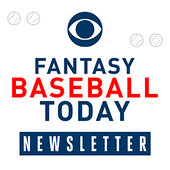
Fantasy Baseball Today Newsletter
Your Cheat Code To Fantasy Baseball
You're destined to gain an edge over your friends with advice from the award-winning FBT crew.


